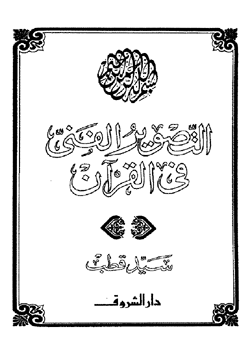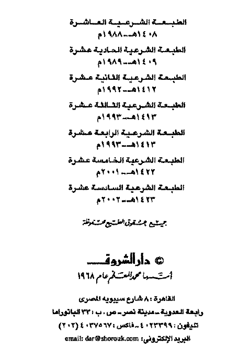From the greatest of distinctions between the true followers of the Messengers and Prophets (in beliefs and methodologies) and those besides them is their affirmation of whatever Allaah affirmed for Himself and which His Messenger (alayhis salaam) affirmed for him in the revealed texts, of Names, Attributes and Actions.
From the greatest of these is Allaah's Uluww (above the heaven, above the Throne, with His Essence). This is a matter that all revealed books and all sent messengers were agreed upon, until the appearance of the Jahmiyyah and the Mu'tazilah. On the basis of an intellectual proof they devised - based upon the language, terminology and classification of the atheist philosophers - to prove the universe is created, they denied much of what has come in the Book and the Sunnah pertaining to Allaah's Names, Attributes and Actions, in order to avoid invalidating their rational proof.
These people were opposed by the entirety of the Salaf, and in the third century, a faction of the Ahl al-Kalaam called the Kullaabiyyah, named after Abdullaah bin Sa'eed bin Kullaab (d. 240H), opposed the Jahmiyyah and Mu'tazilah by being the first of the Mutakallimeen to affirm something of Allaah's Attributes. They refuted the Jahmiyyah and Mu'tazilah on the issue of Allaah's Uluww and in the rejection of the Sifaat Dhaatiyyah. However, uable to counter the arguments of the Mu'tazilah, they denied the Sifaat Fi'liyyah (actions tied to Allaah's will) and through this rejection, concurred with the Jahmiyyah and Mu'tazilah that the Qur'an present with us is created, whilst affirming something additional that the Jahmiyyah and Mu'tazilah did not affirm, which is that there is another uncreated Qur'an, the meaning present with Allaah's Self form eternity which they called "kalaam nafsee". These doctrines of the Kullaabiyyah were taken on by Abu al-Hasan al-Ash'ari (d. 324H) after his split with the Mu'tazilah and they became popularized through the label of "Ash'ariyyah". The essence of the Kullaabi (then Ash'arite) creed was to negate "events (hawaadith)" from Allaah, since to them, everything in the universe is but an event. The early Ash'aris remained upon the creed of the Kullabiyyah in the bulk, affirming Allaah's Uluww and the sifaat dhaatiyyah (such as Face, Hands, Eyes) however, the later Ash'aris reverted back to the doctrines of the Jahmiyyah and Mu'tazilah on these specific issues, and adopted the very ta'weels of the Jahmiyyah and Mu'tazilah that the early Kullaabi Ash'aris refuted. Thus, unlike the early Kullaabi Ash'aris, they denied Allaah is above the Throne, with His Essence and instead adopted the saying of the Jahmiyyah, Mut'azilah and Kafirs like Ibn Sinah (d. 429H) - see here.
Between al-Ghazali, ar-Razi and Sayyid Qutb - The Texts of the Attributes Are Imaginary Depictions Without Realities
We have covered in previous articles what is explicitly stated by the likes of al-Ghazali (d. 505H) and ar-Razi (d. 606H), two Imaams for the Ash'aris, that the texts of the attributes are such that Allaah has deliberately used such language so as to induce Faith in "dumb commoners" (i.e. the awaam, which is the likes of us and you), and that the tajseemi (anthropomorphic) language has been used due to necessity and so as not to make the people flee to atheism, and if such language was used that actually described the realities (Allaah is not a jism, nor an 'arad, nor a jawhar, nor outside the universe, nor inside the universe and so on), then out of a thousand people all of them would turn to atheism except perhaps one.
Being an Ash'ari, it is no surprise that Sayyid Qutb presents a similar concept in his works which continue to be published, distributed and propagated. Below is the book "at-Tasweer al-Fanni Fil-Qur'an" (A Depiction of Art in the Qur'an), and this is a 2002, 16th edition print - you see forty years after Qutb's death, these books continue to be printed and distributed.


In this book (p. 71) Qutb has a chapter called (التخييل الحسي والتجسيم), and essentially, the general theme is the same as what the Ash'aris we have quoted above have explained, however Qutb here is presenting the same idea but from a modern, literary aspect. In his book he even refers to the Qur'an as "magic" repeatedly, from the angle of showing its literary excellence, and this is a clear error, for such words are not applied to the Qur'an. But in this chapter, he explains the meanings of takhyeel hissee (depiction as physical art form) and tajseem (embodiment of meanings) and brings what are illustrations to him of such concepts. Qutb essentially outlines the idea that these techniques have been used in the Qur'an to allow imagination and conceptualization in the mind of the reader, through tangible physical illustrations, to give full expression and understanding in the mind of the reader, even if these are nothing but pure meanings in and of themselves (i.e. without a reality, or without a reality that is known). This is essentially the same as what al-Ghazali (d. 505H) and ar-Razi (d. 606H) and also kafirs like Ibn Sina (d. 429H) believe.
After giving many examples, amongst them the Scales and weighing of the deeds, which according to him would be ma'nawiyy only (meanings only) and not something that is physical, he brings a collection of verses which are the verses of the attributes.

We see here that he has brought the verses that relate to the following: Allah's Hand, Allaah being over the Throne which is over the water, the Kursee, Allaah's Istiwaa over the Arsh, Allaah grasping the Earth with His Hand and the heavens being rolled up in His Right Hand, Allaah coming on the Day of Judgement (and the Angels), Allaah's Two Hands, Allaah raising Eesaa up unto Himself
And after bringing them all he remarks:
وثار ما ثار من الجدل حول هذه الكلمات، حينما أصبح الجدل صناعة والكلام زينة
 And whatever disputation was unleashed, was unleashed regarding these words ....
And whatever disputation was unleashed, was unleashed regarding these words ....
He means here the dispute between Ahl us-Sunnah and the Innovators, and Qutb was not ignorant of the madhhab of the Salaf as we have proven in another article, wherein he said:
 And the saying that "We believe in al-Istiwaa and we do not know its kaifiyyah" does not explain His, the Most High's saying, "then he made istawaa". And it is more appropriate that we say: It is an indirect expression for control, dominion, authority (haymanah) as has we have mentioned.
And the saying that "We believe in al-Istiwaa and we do not know its kaifiyyah" does not explain His, the Most High's saying, "then he made istawaa". And it is more appropriate that we say: It is an indirect expression for control, dominion, authority (haymanah) as has we have mentioned.
So Qutb was upon what he was upon with the knowledge of the way of the Salaf, which he dismissed. And here (in "at-Tasweer al-Fanni fil-Qur'an"), he says:
 And whatever disputation was unleashed, was unleashed regarding these words [at a time] when argumentation was an art and kalaam (rhetoric) was an embellishment.
And whatever disputation was unleashed, was unleashed regarding these words [at a time] when argumentation was an art and kalaam (rhetoric) was an embellishment.
And then he says:
وإن هي إلا جارية على نسق متبع في التعبير، يرمي إلى توضيح المعاني المجردة وتثبيتها
 But these [kalimaat] are but a followed method (i.e. style) in expression which are aimed at the clarification of and affirmation of pure meanings (alone).
But these [kalimaat] are but a followed method (i.e. style) in expression which are aimed at the clarification of and affirmation of pure meanings (alone).
Then he says:
ويجري على سنن مطرد لاتخلف فيه ولا عوج. سنن التخييل الحسي والتجسيم في كل عمل من أعمال التصوير
 [The affair] proceeds upon the unbroken (continuous) customary usage (i.e. language) in which there is no absence or departure. The customary usage of at-takhyeel al-hissee (depiction of physical form in the mind) and at-tajseem (embodiment of meaning) in every act amongst the actions of depiction (tasweer)
[The affair] proceeds upon the unbroken (continuous) customary usage (i.e. language) in which there is no absence or departure. The customary usage of at-takhyeel al-hissee (depiction of physical form in the mind) and at-tajseem (embodiment of meaning) in every act amongst the actions of depiction (tasweer)
Then he says at the end:
ولكن اتباع هذا السنن في هذا الموضع بالذات، قاطع في الدلالة ý كما قلنا ý على أن هذه الطريقة في القرآن أساسية في التصوير، كما أن التصوير هو القاعدة الأولى في التعبير
 However, the adoption (following) of this method in this particular place specifically is definite in indicating - as we have said - that this method is foundational in the Qur'an for depiction, just as depiction (tasweer) is the first principle in expression (ta'beer).
However, the adoption (following) of this method in this particular place specifically is definite in indicating - as we have said - that this method is foundational in the Qur'an for depiction, just as depiction (tasweer) is the first principle in expression (ta'beer).
Essentially what Qutb is saying is that these are just methods, meaning takhyeel hissee (depiction of physical form in the mind) and tajseem (giving embodiment to a meaning) are foundational methods through which meanings are communicated, even if these meanings are in reality only meanings without the depicted reality actually existing. He is merely repeating what was said by al-Ghazali and ar-Razi as mentioned above.
And this is nothing but the fabric of hardcore Tajahhum.
With this, Qutb has made ta'teel of all the attributes he mentioned, and this principle he has mentioned here is not a "slip" or a "mistake" or the likes, because it is upon this very principle that in his commentary on the Qur'an, "az-Zilal" he made Ta'weel of the Arsh, Ta'weel of the kursee, rejected the physical reality of the Scales and the weighing, rejecting Allaah being above the Throne, rejected al-Istiwaa and so on, and we have documented some of these things already (others to follow):
This foundation which Qutb has outlined and explained, and which is published and distributed the world over, reaching 16 editions over 50 or so years, then this foundation is a Jahmite foundation up which the ta'teel of Allaah's Sifaat are founded upon.
Then we have a people claiming Sunnah and Salafiyyah (spuriously), and claiming defence of the aqidah, boasting of their refutations against the Ash'arites and having won battles against them, the while they swim oceans, conquer mountains and dig into the recesses of the earth, all to defend this man with their bodies, their wealth and their possessions, hating and despising that this man's status be diminished in the eyes of the people and that his works (in which their fikr and harakiyy da'wah is outlined) are shunned. A strange, strange phenomenon indeed!

